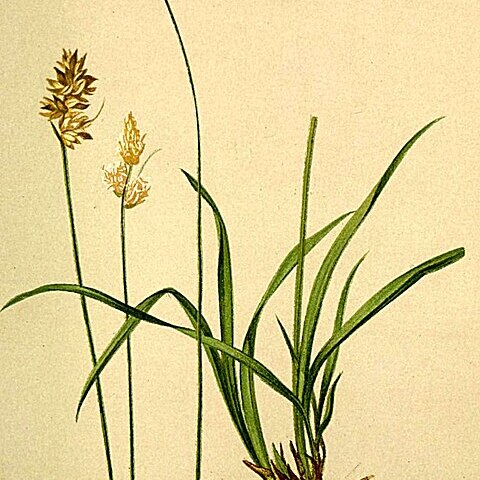Tufted from an ascending rhizome. Culms 3–10–(20) cm. × c. 1 mm., trigonous, wiry, glab., occ. scabrid above; basal sheaths cream, grey or light brown. Lvs us. < culms, < 2 mm. wide, slightly striated, channelled, sts flat, grasslike, tips obtuse to subacute, margins faintly serrulate towards the tip. Infl. a single dark brown terminal head, 8–15 mm. long, of 2–4 contiguous spikes; subtending bracts not conspicuously different from glumes. Spikes androgynous, 5–8 mm. long, male fls at base of spike. Glumes ± =, or slightly < utricles, broadly ovate, obtuse or sub-acute, dark brown with a lighter brown midrib and very broad, pale brown, hyaline margins. Utricles 2.5–3 × c. 1.5 mm., plano-convex, oblong-ovoid, indistinctly nerved, margins glab., contracted to a narrow dark brown to black beak slightly > 0.5 mm. long, puckered below to a broad pale brown stipe, < 0.5 mm. long. Stigmas 2. Nut c. 1.5 mm. long, oblong-obovoid to almost orbicular, light brown.
Rhizome oblique. Culms loosely tufted, 8-20 cm tall, obtusely trigonous, smooth, slightly scabrous above, clothed at base with pale brown sheaths. Leaves shorter than culm, blades linear, 1-2 mm wide, flat or slightly involute. Involucral bracts glumelike. Spikes usually 3, upper 2 gynaecandrous, lower spikes female or gynaecandrous, terminal spike clavate, 0.8-1.2 cm, remaining spikes rather small, elliptic, rarely ovate, 4-8 mm. Female glumes brown, elliptic or ovate, with green midrib. Utricles yellow-brown below, dark brown above, longer than glume, ovate or obovate, plano-convex, ca. 3 × 1 mm, obscurely finely veined, base broadly cuneate, stipitate, apex gradually tapering into a smooth blackish beak, beak deeply cleft abaxially at orifice. Nutlets rather tightly enveloped, ovate-elliptic or elliptic; style base not thickened; stigmas 2. 2n = 64.
Small wiry tufts, usually to 10 cm high. Leaves < stems. Inflorescence a single erect dark red-brown head, 8-15 mm long, of 2-4 sessile, contiguous spikes with short glume-like bracts. Male flowers at base of spikes. Utricles wingless, scarcely beaked. Stigmas 2.


